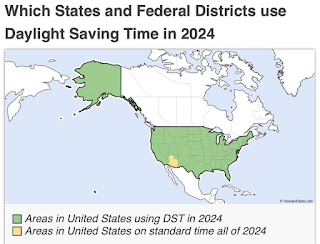Daylight Saving Time
On Sunday, November 3, 2024 (the first Sunday in November), at 2:00 AM, clocks were turned backward one hour to 1:00 AM. This was officially the end of Daylight Saving Time (DST) in the US, time to “Fall Back.”
Humans may or may not appreciate the change in time. My dogs, however, think I am the worst person on earth for “delaying” dinner time. I am convinced they have an internal alarm clock. One pup is whining at my side while I write this blog post.
DST was first observed in 1918 to conserve energy during WWI and WWII, to permit more cost-effective war-time production, and to mitigate blackouts. In fact, at times, it was called “War Time.”
From 1945 to 1966, there were no uniform DST rules, which was chaotic for broadcasting and transport. The Uniform Time Act of 1966 aligned switch dates across the US.
There were two periods after the 1973 Oil Embargo when the DST period was extended to try to save energy: ten months in 1974 and eight months in 1975. Over the next 11 years, the DST schedule was revised several times.
From 1987 to 2006, the time changes occurred on the first Sunday in April and the last Sunday in October, lasting seven months each year. The current time change schedule was adopted in 2007 to follow the Energy Policy Act of 2005, which extended DST by several weeks.
Per section 110 of this act, DST is governed by the US Department of Transportation (DOT). States have the right to choose not to observe DST. Hawaii, all of Arizona (except for the Navajo Nation region), and the US Dependencies (Territories) do not observe DST.
Worldwide, there is a greater variance in the use of DST. Vast areas that once utilized DST no longer do.
Are you for or against DST? For now, biannual time change is the law of the land, and DST will resume on the second Sunday in March, March 9, 2025. Once again, the clocks will be turned forward from 02:00 AM to 03:00 AM. Time to “Spring Forward.”













Comments
Post a Comment